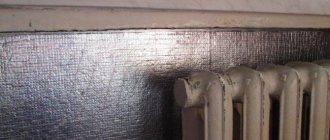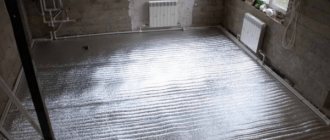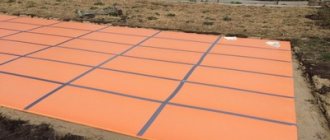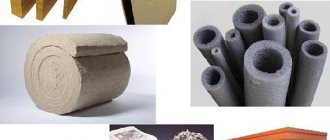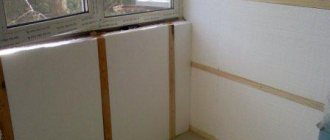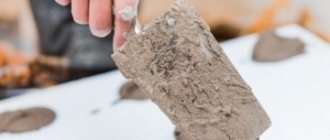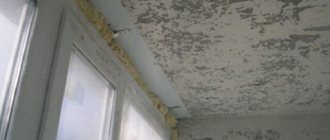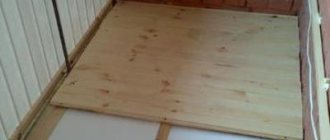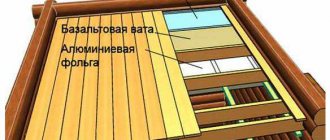What is Penofol and its analogues
Thin polymer insulation is made from the following materials:
- The main insulating layer is foamed polyethylene 3...10 mm thick with closed air pores. The thermal conductivity coefficient λ of this layer lies in the range of 0.037–0.051 W/(m • °C) depending on operating conditions.
- The outer reflective layer is aluminum foil 14 microns thick, securely glued to a polymer base.
- The third layer on the back side of the polyethylene can be glue for ease of installation or the same aluminum.
Reference. All given characteristics are taken from the official website of the manufacturer. Thermal insulation parameters of other brands may vary. For example, the thickness of a similar material reaches 150 mm.
A special feature of the material is its impermeability to moisture, the declared indicator is simply scanty - 0.001 mg/m • h • Pa. The insulation is quite light - the density ranges from 16...35 kg/m³, and is sold in rolls. Thanks to these parameters, the material serves well as an internal vapor barrier.
"Penofol" is available in 3 versions:
- double layer type A;
- three-layer – the base is coated with aluminum on both sides (type B);
- the same, with an adhesive layer - Type C.
The foil side works as a reflector of the radiant (infrared) component, polyethylene foam resists direct heat transfer. For exterior wall cladding, a perforated version of Penofol, shown in the photo, is offered. Many small holes are designed to allow water vapor to escape from the thickness of building structures.
External wall cladding is made with special insulation with perforation
Scope of application
With the help of Penofol, you can significantly increase the energy efficiency of any home - a private house or apartment. Where the material is used:
- thermal insulation of the roof of an attic or cold attic;
- covering ceilings and walls from the inside - as an addition to the “pie” of basic insulation;
- under the finished floor covering laid along the joists;
- strengthening the outer thermal insulation layer;
- internal insulation of balconies and loggias;
- coating of heating pipes and ventilation ducts.
Addition. Many drivers use “penofol” type C (adhesive surface) to insulate the car body – interior floors, doors and roof. The cut blanks are glued to the metal on top of the bitumen vibration insulation.
It is not advisable to use the material as an independent insulation of external fences - you will not achieve the desired effect, only protect the building from wind blowing. An exception is products of large thickness from 20 to 150 mm of the Tepofol brand, suitable for complete insulation of a house.
Penofol ceiling insulation technology
The product can be laid on a floor made of any material, but operations must be performed in a certain sequence. Deviation from the technology of installing penofol on the ceiling will reduce the expected effect. In addition to the insulation, you will need glue to fix the insulator and metallized tape for the joints. The rules for choosing the components of the insulating “pie” are written below.
Tools and materials for work
If the ceiling is insulated with isolon (penofol) from the inside, then the following materials and tools will be needed for the work:
- wooden slats for lathing;
- drill or hammer drill;
- screws and dowels;
- wood screws;
- hacksaw;
- laser level;
- Ruler and pencil;
- roulette;
- foil insulator (material of the smallest thickness and a product of primary purpose);
- reinforced tape;
- ceiling primer;
- roller;
- putty;
- putty knife;
- containers for mixing solutions;
- scissors or a stationery knife for cutting insulation;
- construction stapler and staples;
- ladder.
Selecting consumables
For reliable insulation, along with penofol, glue is purchased for fixing to the surface and adhesive tape for connecting parts of the canvas. There are several modifications of penofol that can be used to insulate the ceiling:
- Type "A"
. Foil on one side only. Usually used with other thermal insulators as additional insulation. - Type "B"
. Foil film is located on both sides. It has proven itself well as the main heat insulator. - Type "C"
. There is a sticky layer that makes it easy to attach. - Type "ALP"
. The metal coating is protected with polyethylene film. They are often placed on the floors of specialized premises - greenhouses, incubators, chicken coops. Film-reinforced insulation is used in basements where it is not protected by a suspended ceiling.
It is not recommended to buy Penofol-2000. Its cost is low, but it retains heat poorly. Before insulating the ceiling with penofol, check the quality of the product. Pay attention to the following factors:
- The product must be manufactured in accordance with the requirements of TU 2244-056-4696843-98.
- The material is sold in rolls, the length of the product depends on its thickness.
- Tears and through holes are not allowed on the canvas.
- The winding of the rolls is tight, without distortions. The product is packaged in plastic film, the edges of which are secured with adhesive tape.
- Make sure that the product is stored on racks or pallets at a temperature of 20 degrees and a relative humidity of 50-70 percent. It is not allowed to store material closer than 1 meter from heating devices.
Products must have a label containing basic information:
- Name of the manufacturer;
- Basic dimensions;
- Release date and warranty period, usually the manufacturer allows storage of the material for no more than 1 year;
- Thermophysical indicators;
- Scope of application of the material;
- The protective layer on type “C” samples should be easy to peel off.
Varieties
Despite its apparent simplicity, it has several varieties that differ greatly in their characteristics:
- Type "A". This is the most common species. It is covered with a foil layer on only one side.
- Type "B". The foil coating is already on both sides of the material.
- Variety marked “C”. It will differ from the others by the presence of a self-adhesive coating on one side. This is a very useful feature during installation.
- The type of polyethylene foam, marked with the letters “ALP”, has a foil layer on both sides, but at the same time, one of the foil-covered sides is also protected by a film coating.
- Penofol types “R” and “M” have foil on only one side, but have a relief structure.
- Products marked “AIR” are used to create air ducts.
- Another type, marked with the word “NET”, is used for thermal insulation of heating mains, air ducts and pipelines.
The last four types are not used very often, but rather on a specialized basis. Therefore, you are unlikely to encounter them in everyday use. But polyethylene foam, designated by the letters “A”, “B” and “C”, can be found much more often, and is actively used for domestic purposes, among which the main thing will be the insulation of all kinds of surfaces.
The first type of this heat insulator is mainly used as an auxiliary material when creating a thermal cushion. It works well as a vapor barrier.
For complete heat conservation, a material with more significant characteristics is needed. It is best to create an independent layer of thermal insulation, use either polyethylene foam, marked with the letter “B”, or, a variety, marked “C”.
Advantages of foil insulation
An important advantage of such insulation is the foam base. Thanks to it, a layer of air is securely retained, which has minimal thermal conductivity. This is what allows maximum retention of warm air inside the room.
It is not necessary to level the surface before using insulation
Other advantages that insulation has:
- The material is not flammable. This makes it possible to safely use it indoors in any room. Including residential ones.
- High sound insulation rate. Foil insulation is often used as additional protection against noise penetration into the room.
- Lightweight and thin. These characteristics allow the installation of canvases in conditions where other types of insulation cannot be installed.
- The structure of the material allows moisture and steam to pass through. Thanks to these indicators, there is no need to use additional moisture insulation around the insulation.
- Good elasticity. Most types of foil insulation have a similar indicator. This saves time on leveling the surface.
- Environmentally friendly. All types of foil-based insulation are absolutely safe for human life. The fabrics are not able to emit harmful fumes during the entire period of operation.
- Relative ease of installation. To attach material, it is not necessary to have special skills or involve specialists. You can do this kind of work yourself. To carry out installation, it is enough to prepare a minimum set of tools (stapler, scissors, stationery knife, tape measure, pencil).
Finishing foil insulation with wooden clapboard
Like all materials, foil insulation has its drawbacks. One of these is the insufficient rigidity of some types. For this reason, canvases cannot be covered with a finishing layer or plastered. This is especially true for foil polyethylene foam. As for fastening, it is not recommended to fix such material with glue. The best option is nails and staples. That’s why, by the way, polyethylene foam manufacturers invented and launched the production of self-adhesive versions of this insulation.
Folgoizolon - foil insulation for the ceiling
Folgoizolon is a fairly new insulation on the market, providing high-quality heat, moisture and noise insulation. The basis of the material is polypropylene or foamed polyethylene. Based on this, two types of products are distinguished, designated PPE and NPE.
Advantages of folgoizolone:
- lightness of the material , which makes it possible to finish any base, provided there is no need for preliminary measures to strengthen it;
- small thickness - does not reduce the dimensions of the room, maintaining its usable area;
- elasticity - unlike some insulation materials (such as polystyrene foam boards), this foil material allows you to avoid spending time on careful preliminary leveling;
- multifunctionality , or a “3 in 1” combination, contributes to a significant reduction in the costs of purchased materials (mastics, films, fasteners, etc.) and a reduction in construction or repair time;
- ease of cutting - foil isolon can be easily cut with a sharp knife, which eliminates the need to use specialized tools;
- the absence of moisture absorption is one of the most important factors that ensures the extension of the service life of not only the foil-isolon itself, but also the structural elements it covers;
- environmental safety - does not emit harmful substances even at temperatures above 100ºС. Among other things, this material will never harbor insects or rodents.
So, is it possible to insulate the ceiling with foil insulation? Taking into account the material above, we can safely give a positive answer.
Is it worth insulating a house with foil insulation?
This also helps to reduce external noise levels and get rid of drafts. The anti-corrosion properties of aluminum foil are useful in rooms with high humidity (baths, saunas) or when condensation occurs. Insulating the chimney, in particular with stone wool insulation, will help avoid unnecessary heat loss into the air.
Important positive qualities include low cost with a long service life - up to 50 years. The ability to install the insulator yourself without involving specialists is also appreciated.
The disadvantages of this material stem from its advantages: insulation with foil retains not only heat, but also moisture and odors. These side effects are most noticeable when you want to wrap the entire house in foil: floor, walls, ceiling. In this case, regular ventilation of the premises is recommended.
With maximum use of foil insulation, especially in rural areas, the cellular signal strength is likely to decrease, which can lead to frequent disconnections while talking or using the Internet. Placing the PC or the subscriber itself closer to the window will solve this problem.
How to attach isolon to the ceiling
.
how to glue isolon to concrete
During the construction of industrial facilities and residential buildings, modern building materials are used to meet the most important construction requirements for heat and sound insulation.
Such material, for example, is isolon or polyethylene foam.
The use of isolon allows you to reduce construction time and heating costs due to the excellent thermal insulation properties of this material.
Isolon has the following characteristics: 1. Low density (light weight) and at the same time good thermal insulation properties. A 10 mm layer of isolon can replace a 15 mm layer of mineral wool, 45 mm of wood or 150 mm of brickwork.
This reduces the weight of structures and helps save usable space; 2. Freons and other substances hazardous to humans are not used in the production of isolon. Izolon is non-toxic, does not affect the skin, and does not emit harmful substances when used. Has a hygiene certificate; 3.
Isolon is a chemically inert material and is not affected by organic solvents. It is possible to combine isolon with other building materials (concrete, gypsum, cement, lime, wood). It practically does not absorb water and steam, therefore it is resistant to rotting, mold and aging; 4.
Excellent shock-absorbing properties due to flexibility and uniform cellular structure. Isolon is used as a backing for carpet, laminate, linoleum or parquet. Izolon sheets are used to separate adjacent walls if adjacent walls are subject to movement or vibration; 5.
The operating temperature range is from -60`С to +75`С, and if there are no mechanical loads, the operating temperature increases to +100`С. With the exception of special isolons with fire-extinguishing additives, isolon is a flammable material.
But at temperatures less than +140`С no harmful substances are released from isolon; 6.
Izolon is produced in different thicknesses and densities (with different foaming coefficients) and is supplied in the form of rolls, sheets, tape or blocks.
This significantly increases the possibilities of using isolon in construction.
Depending on the production method, isolon is divided into cross-linked (when molecules are cross-linked, a network molecular model is formed) and non-cross-linked (there are no chemical bonds between the polymer molecules).
Cross-linked isolon has improved characteristics compared to non-cross-linked isolon: 1. Heat resistance increases (the operating temperature range increases by 20°C); 2. The service life of the material increases due to increased resistance to ultraviolet radiation and organic solvents: oil, gasoline, diesel fuel; Izolon can be used 1.
For sound, steam, heat, waterproofing of walls, foundations, floors and roofs for country houses, cottages, garages; 2. As a sealant under slate, ribbed metal roofs or tiles; 3.
Isolon tapes with an adhesive layer seal the joints of windows and doors, connections between the frame and glass, protect against dust, moisture and noise; 4.
Izolon strips can be used to insulate cold and hot heating pipes, as well as ventilation pipes; 5.
Technology for attaching isolon to the wall and material variations
Isolon with a metallized polymer film is used as a heat-reflecting screen to protect against heat loss through the areas behind the radiator walls. When using a combined material, a double effect is obtained.
Due to the metallized film, up to 90% of the heat emitted by radiators or other heating devices is reflected back into the room. The big advantage of isolon is its ease of use and installation. It is easy to cut and can be glued to the surface with adhesives (pre-glued surfaces should be cleaned of dust and degreased).
To attach to a smooth surface, use screws, slats, and furniture staplers. To connect the joints, use a hair dryer. Isolon is attached to curved surfaces with double-sided mounting tape.
Thus, when using this modern material, it is possible to significantly reduce construction time and heating costs.
: https://avtoladagood.ru
Foil insulation: advantages, disadvantages and installation features
To reduce heat losses in a private house, apartment, bathhouse or similar buildings, building insulation with foil (folgoizol) is often used.
In addition to maintaining a comfortable temperature in the room, it protects the living space from external noise.
The aluminum base is not subject to corrosion, which makes this material safe and durable in conditions of high humidity and temperature.
Foil insulation - purpose and properties
The main property of folgoizol is reflected in the name - heat preservation.
Unlike most analogues, insulation with aluminum foil consists of two components: in addition to the metal strip, it contains a mineral base. It is represented by three main types of polymers:
- Polyethylene foam is the cheapest option for foil insulation and the thinnest of its types. Its thickness is 2–10 mm. Most often, foiled polyethylene foam is used as a substrate for laminate flooring.
- Fiberglass is the most commonly used in construction. In addition to the ability of metal to reflect heat inside, this type of thermal insulation perfectly prevents the penetration of cold from the outside. This is achieved due to the low density of the fiberglass sheet, which has an air gap between the thin threads. This foil insulation is used to insulate floors, walls and ceilings of buildings.
- Stone wool is intended for use in extreme temperature conditions: thermal packaging of pipes, saunas, steam rooms in baths.
The vast majority of all these materials are covered with aluminum foil on one side. The only exception is polyethylene foam: some seals are metallized on both sides.
Advantages and disadvantages of foil insulation
The advantages and popularity of foil insulation are explained by its ability to reflect IR radiation back into the room, thereby significantly reducing heat loss and saving energy consumption, for example, wood for a fireplace or stove. Fiberglass products, due to the air content between the fibers, are similar in temperature regulation to animal fur. This also helps to reduce external noise levels and get rid of drafts.
The anti-corrosion properties of aluminum foil are useful in rooms with high humidity (baths, saunas) or when condensation occurs. Insulating the chimney, in particular with stone wool insulation, will help avoid unnecessary heat loss into the air.
Important positive qualities include low cost with a long service life - up to 50 years. The ability to install the insulator yourself without involving specialists is also appreciated.
The disadvantages of this material stem from its advantages: insulation with foil retains not only heat, but also moisture and odors. These side effects are most noticeable when you want to wrap the entire house in foil: floor, walls, ceiling. In this case, regular ventilation of the premises is recommended.
With maximum use of foil insulation, especially in rural areas, the cellular signal strength is likely to decrease, which can lead to frequent disconnections while talking or using the Internet. Placing the PC or the subscriber itself closer to the window will solve this problem.
Features of the use and installation of foil insulation
The most important point for using all the best qualities of the material is the direction of installation - with foil inside the room.
The maximum efficiency of an aluminum thermal reflector is achieved if there is an air gap of 20–30 mm between it (foil) and the decorative cladding of the walls or ceiling.
To do this, it is enough to mount the frame of slats directly on the foil insulation. It is better to lay insulation sheets end-to-end rather than overlapping.
How to properly install foil insulation - installation secrets, characteristics
The seams are connected and sealed with foil tape.
Conflicting reviews about the benefits of foil underlayment under laminate flooring are due to the lack of the recommended air layer between the metal and the bottom of the flooring. However, as experience shows, the thermal effect is also present in this case, especially on unheated floors or when assembling laminate flooring on a balcony. As a compromise, it is possible to lay a thin painting mesh on the foil.
It is worth choosing insulation with aluminum foil depending on the repair area.
Fiberglass foil insulation is used for walls and ceilings, but in rooms with high humidity and open fire it is safer to install stone wool insulation. Any type of insulator against cold, noise and moisture is easy to install yourself, but if you lack experience, it is better to turn to professionals.
: https://azbstroy.ru
How to glue isolon to concrete
.
Not long ago a new product appeared on the building materials market - foil insulation. It is used for waterproofing, sound insulation and thermal insulation of facades, roofs, walls, floors, ceilings, saunas, baths, partitions, pipelines. What is foil insulation, and how to install it correctly?
Foil insulation is used for waterproofing, sound insulation and thermal insulation of facades, roofs, walls, floors, ceilings, saunas, baths, partitions, pipelines.
What is foil insulation?
Foil insulation is a combined material. On one side it is a polished foil, and on the other - pre-foamed polyethylene. Thanks to its “aluminum” component, it is capable of reflecting and retaining heat in the room.
According to research, the reflection effect is 97%. It is distinguished by its thinness and excellent water-repellent qualities, so that the walls and floors do not become damp. In addition, this material perfectly protects the building from wind and frost.
Due to the properties of foil, almost all the heat remains inside the room.
Among the advantages of such insulation, experts also highlight excellent soundproofing properties, ease of installation and high environmental friendliness.
It does not emit hazardous and toxic substances, unlike conventional mineral wool and other modern analogues.
Due to its elasticity, foil insulation is easily and safely mounted on the surface, and even a non-professional can install it correctly simply using the simplest instructions.
Types of foil insulation
Foil insulation does not emit hazardous and toxic substances, unlike conventional mineral wool.
There are four types of such insulation; they differ from each other both in appearance and in their area of application and functional features.
- Foamed polyethylene coated with aluminum is used to insulate building walls and ventilation systems. Usually sold in roll form.
- Foiled polystyrene foam is used for floor insulation. It is produced in the form of thick steel-colored sheets.
- Mineral wool with a layer of foil is used mainly for insulating roofs, chimneys and baths. Sold in rolls.
- Basalt foil-coated thermal insulation material is used in all areas of construction, including the construction of gas stations. It has increased resistance to aggressive environments. Withstands temperatures from -200°C to +700°C.
Application of material
This material is ideal for insulating floors, bathhouses and attics - this way you will provide excellent hydro-noise and heat insulation.
How to insulate a bathhouse with isolon with your own hands
In addition, many people use it to increase the amount of heat supplied by placing it behind the radiators with the “aluminum” side facing the room. As a result, for little money you can protect your home as much as possible from wind, frost and heat loss.
Installation: how to do it right?
Foil insulation is ideal for insulating floors, bathhouses and attics.
Required tools and materials:
- construction stapler;
- small nails;
- hammer;
- foil insulation;
- foil tape.
Many people, having bought foil insulation, wonder which side to lay it on correctly?
So, the first thing to consider is that the reflective surface of the insulation must be located indoors.
This is necessary to keep the heat in the room. In addition, it is important to leave a distance between the finish and the material of about 15-20 mm; this kind of air cushion will provide additional heat protection.
When laying on an insulated surface, the material must be in a wooden sheathing (2-3 cm thick) between the guides. Correctly attach it to the wall not overlapping, but end-to-end, using nails or a stapler. After all the sheets have been laid, the joints between them are taped with special foil tape. At this point the installation can be considered complete.
//1metallocherepica.ru/youtu.be/czIlH8kHIpY
The cost of any insulation with aluminum foil is comparable to the cost of an alternative material with similar characteristics, but due to the fact that its installation is very simple, you can save a lot of time on installation and space (foil insulation is thinner than conventional ones).
In addition, this material is environmentally friendly and fireproof. Before you choose and buy foil insulation, make sure that it is covered with aluminum foil and not aluminum coating. In the second case, the reflective properties of the material are unlikely to work correctly.
Source: https://stroyvolga.ru/%D0%BA%D0%B0%D0%BA-%D0%BA%D1%80%D0%B5%D0%BF%D0%B8%D1%82%D1% 8C-%D0%B8%D0%B7%D0%BE%D0%BB%D0%BE%D0%BD-%D0%BA-%D0%BF%D0%BE%D1%82%D0%BE%D0 %BB%D0%BA%D1%83/
How to properly glue foil insulation
Instructions for use of stekloizol and folgoizol
Folgoizol and stekloizol grades K (FK and SK) are intended for the installation of the top layer of rolled carpet on roofs with various slopes and configurations of buildings located in climatic zones 2, 3 and 4.
Folgoizol and stekloizol grades G (FG and SG) are intended for the installation of a protective waterproofing coating for thermal insulation of pipelines.
Work on installing a roof or protective waterproofing must be carried out in accordance with current building codes and regulations (SNiP 3.04.01-87 Insulating and finishing coatings, VSN 32-81 “Instructions for waterproofing bridges and pipes on railways, highways and city roads”) .
The installation of a roof or protective insulation can be carried out on a pre-primed base by melting or liquefying (plasticizing) the binder layer, as well as gluing with hot or cold adhesives. The base surface for roofing or insulation must be properly prepared:
compacted and leveled; cleared. dust free. dried if necessary;
primed with a continuous layer without gaps or breaks.
Insulation and roofing work can be carried out from 60 ° to minus 30 ° C in the environment (with the use of hot mastics - at a temperature not lower than minus 20 ° C; when gluing the binder layer by liquefaction (plasticization) with the simultaneous laying of rolled carpet, liquefaction should be carried out at a temperature air not lower than 5 ° C).
When working in sub-zero temperatures, glass (foil) insulation must be heated to a temperature of at least 15 ° C within 20 hours, rewound and delivered to the place of installation in an insulated container.
Before sticking, roll materials must be marked at the place of installation; The layout of panels of rolled materials must ensure that their overlap is 100 mm. when sticking (on the roof ridge the overlap on the opposite slope should be 250 mm - when sticking panels across the slope and 1000 mm - when sticking along the slope).
Thermal insulation with foil for pipes
Shell with foil for pipes based on mineral wool.
Foil thermal insulation for pipes is needed when laying communications through the air or underground. Also, to reduce heat loss by the coolant, such material is used even in a room, especially an unheated one, which is not uncommon for a boiler room in a cottage, which is usually located on the ground floor.
Installation does not require special instructions, since using insulation with foil is as easy as shelling pears. You just need to put the shell on the required segment and, in some cases, remove the protective film from the adhesive surface applied along the end of the longitudinal cut. The reflective surface protects communications from solar radiation if it is applied only on the outside. If there is a reflective surface on the inside, then it transfers heat back to the pipe.
Features of using foil insulation
The reflective properties of foil help retain heat inside the building. To do this, the sheets are mounted with the foil surface facing the room. To get maximum results, the canvases need to be attached end-to-end.
Also, to increase characteristics you should:
- Tape the seams. To do this, use a special metallized type of tape.
- Create an air cushion. It is formed on both sides of the laid material. A sheathing is first made, on which the canvas will later be attached.
Important! It is strictly forbidden to install this material overlapping. Such fastening reduces its thermal insulation ability. There is also a high probability of the resulting condensation draining into the room.
Fastening foil insulation using a stapler
Each type of material has its own installation characteristics. As for polyethylene foam, its installation is the simplest. The canvases are secured using construction staples. Since such insulation with foil is the thinnest, when laying it you can allow overlap within 10 centimeters. Ventilation gaps should be left on both sides. Their optimal size should be 1 to 2 centimeters.
Before installing foil insulation on the ceiling and walls, you need to pay special attention to insulating the wiring. For this you can use both corrugated pipes and plastic channels.
As for laying insulation based on mineral wool, the sheets should be fixed as tightly as possible. Compliance with this rule will avoid the formation of bridges. It is not worth using force in such work, since the rather fragile sheets can be deformed.
Finally, about other use cases
Home craftsmen use insulation made from foamed polyethylene for a wide variety of purposes:
- protection of heating and hot water pipes from freezing;
- interior decoration of entrance door leaves;
- reflective screen glued to the outer wall behind the heating radiators;
- inexpensive thermal insulation of outbuildings - sheds, workshops, garages;
- exotic – shoe insoles made of 3 mm thin sheet insulation.
Polymer insulator "Penofol" is a material that deserves attention. If applied according to the instructions, it will serve as a good insulator. But do not try to save money and solve all thermal insulation problems using thin polyethylene alone; use other effective insulation materials.
Complex insulation of a balcony with Izolon
In the photo the balcony is ready for finishing.
Insulation of a balcony with Izolon, like a loggia, should be carried out comprehensively. This means that thermal insulation must be installed everywhere: on the floor, ceiling and walls. Please note that without good, energy-saving windows, no insulation will help. The lion's share of the heat escapes through the glass (this is if everything is sealed). We have already written about how to check heat loss. High-quality insulation of a balcony with Isolon alone is nonsense; thick thermal insulation materials are needed. The best option is foam with a density of 25 kg/m. cube
We present to your attention the fastest and easiest way to comprehensively insulate a balcony:
- foam is glued to the walls and ceiling with adhesive foam;
- guides are placed on the floor level;
- between the guides you can simply put polystyrene foam in two layers with the joints spaced apart, all the cracks are foamed with the same adhesive foam;
- the entire balcony is covered with foil insulation with the shiny side in the middle of the room, the joints are taped;
- Logs are placed on the floor guides, and everything is covered with OSB board - the floor is ready;
- wooden blocks are drilled into the walls and ceiling through the foam plastic - this is the sheathing;
- trim is attached over the sheathing.
This method minimizes the use of an impact drill, and there is no need to dilute universal construction adhesive. It saves time and nerves, and the results are excellent. Everything will hold securely and will never fall off; you won’t even be able to tear it off on purpose.
Now let’s summarize our article today about Izolon. Insulation for floors, walls and ceilings without foil works more as sound insulation, protection from steam and moisture. Often used as a lining under laminate or even linoleum. The thermal insulation qualities of foamed polyethylene are quite high (0.037 W/m*C), but with a small thickness the effect is insignificant. Foil materials emit IR rays, which is very useful, especially in a bathhouse. There should be a gap of 15 mm or more between the foil and the trim.
Technology for attaching isolon to the wall and material variations
The modern construction market is replete with all sorts of new products, often universal materials with a wide range of applications. We will talk about one of these materials today. This miracle of engineering called “izolon” is widely used in construction as a heat and sound insulating material. Later we will describe all its capabilities in more detail.
First, let’s concentrate on the main value – insulation of walls and floors. Attaching an isolon to a wall is a very simple process, but to the floor, in general, is as easy as shelling pears.
The principle of fastening is similar to other soft-type insulation - they are attached to the wall using lathing, which also serves as a frame for future wall decoration, for example, plastic panels.
There are technologies for using isolon both indoors and outdoors.
The second option is more practical (cold air is cut off, the walls do not freeze, and the heat from inside the house does not escape anywhere), but it is also more financially expensive, since the walls are insulated with insulation from the outside mainly under the siding.
How to insulate - from the inside or outside - is up to you, but we will try to tell you in more detail about mzolon itself, the range of its applications, technical characteristics and other interesting facts.
What is isolon?
Izolon is a universal insulation product made of elastic polyethylene foam, providing all types of insulation. The widest range of isolon is presented in:
- A material treated with electric discharge and capable of being wetted with adhesives and paints.
- Foil laminated rolls.
- Rigid and heat-resistant sheets.
- Multicolored.
- With a reduced level of flammability.
Insulating material – isolon
All these are various subspecies of amazing material, but they all have:
- The unique thermal insulation property of thin material (1 cm), which can be replaced by 5 centimeters of wood or mineral wool, 150 millimeters of brickwork, 12 millimeters of polystyrene foam.
- Effective protection against steam and moisture due to the closed cell structure. Water is not absorbed by the material.
- Excellent sound and shock insulation.
- Softness, elasticity, low weight (except for hard tile samples).
- Durability, resistance to rotting, low level of flammability, which provides it with a warranty period of up to 90 years
- Chemical stability, which allows it to be combined with all known materials.
- Environmental safety, since the material does not have a strong odor and does not emit toxins either when heated or at rest. The materials from which Izolon is made do not harm nature, even contact with food is allowed, so insulating walls with Izolon inside is completely safe.
- Versatility and ease of installation. This material is excellent for floors, walls, both internal and external, and roofs in residential and commercial premises. Installation can be carried out by anyone, even those without construction skills.
Izolon also differs in production technology into uncrosslinked and crosslinked.
If we talk about the first type, then it is simply foamed polyethylene, in the structure of which there is a small number of chemical bonds, while in the second the molecules are cross-linked together, thus the structure is modified, which makes it possible to achieve an increased level of thermal insulation, resistance to temperature changes and the effects of organic solvents .
How to use?
The scope of application of isolon goes far beyond the boundaries of the construction field: it is actively used in the production of automobiles, refrigeration equipment, the medical industry, for plumbing needs, and even in the oil industry. It has also found its application in the production of life jackets, sports equipment, and packaging.
Most often, izolon is used for installing heated floors and insulating loggias and balconies. There are technologies that make it possible to use isolon in insulating external and internal walls and roofs, but the principle, as they say, is the same.
The only difference is that in cold, unheated rooms, which include a balcony, one isolon is not enough, then a sandwich technology of cotton wool insulation or polystyrene foam and foil isolon is used.
If the room is small and you cannot allocate additional space for insulation, then you should increase the thickness of the isolon to at least 2 centimeters. Using the example of insulating a loggia, we will show the principle by which you can insulate (with certain deviations depending on your conditions) any surface.
Very few people still know how to properly attach isolon, since the technology is quite new. Izolon on the walls is placed with foil inside to reflect heat.
If you prefer a sandwich, then between two layers of isolon there is a gasket made of mineral or glass wool, polystyrene foam, expanded polystyrene, and a lathing for decorative design materials, such as plastic panels, lining, etc. is mounted on top.
All seams are carefully taped with special reflective tape; tightness during the insulation process is very important, so this advice should not be neglected.
In order to describe all the processes more clearly, here are brief step-by-step instructions:
- Clean and dry the surface to which the attachment will be made.
- Measure the area, prepare the required amount of material.
- Lay out and attach the isolon to the surface with the foil facing you.
- Tape all existing seams and fastening points with special tape.
The manufacturer gives several more ways to use isolon:
- Using sheets for hardening concrete - isolon prevents heat loss and rapid drying, therefore it is invaluable as a material for laying concrete.
- As a bedding under artificial turf.
- As dividing partitions when pouring the foundation.
- When insulating water supply, drainage, ventilation pipes.
- As heat-reflecting screens (attaching the isolon to the wall behind the radiator allows you to redirect warm air masses into the room, which prevents rapid cooling. According to statistics, energy savings in this case exceed 25%).
Alternative types of materials
There is no alternative to isolon as such, but we would be wrong if we do not briefly talk about materials that in certain cases can replace it.
cotton wool
Cotton materials, which include mineral wool, glass and ecowool, have almost the same heat and sound insulation properties as isolon. Their manufacturers insist that their main advantages are:
- Lightweight and easy to install.
- Low thermal conductivity.
- Strength under compression, mechanical stress, ruptures.
- High sound insulation characteristics.
- Not susceptible to fire.
- Resistance to temperature deformation.
- Biological and chemical resistance.
Use of mineral wool in insulation
Mineral wool is available in the form of rolls and sheets and has different softness and thickness. It is extremely easy to install structures using various types of wool:
- The walls must be covered with a steam or hydrobarrier using a stapler.
- The next step is to assemble the frame from special metal profiles, the assembly step is 50 centimeters.
- Then cotton wool is laid, carefully distributed throughout the entire space, avoiding gaps.
- Then the cotton wool is fixed in any convenient way, the structure is covered with sheets of plasterboard, plastic panels, clapboard, fiberboard.
- The final stage is finishing the walls; its type depends on what material you have chosen or what is available.
The disadvantage of the material is its allergenicity; you should work in protective gloves and a mask to prevent contact of the material with the mucous membranes and skin of the hands. It also requires additional vapor barrier, since it loses its properties from moisture. In principle, the technology is simple and you can easily do everything yourself without overpaying to contractors.
Foam plastic or its analogues
The undoubted advantages of polystyrene foam include the following:
- Polystyrene foam is not afraid of moisture.
- It is a good heat insulator.
- Not susceptible to rotting, fungal or mold stains.
- Easy to install and cut.
- Has low weight.
- Heat resistant to low temperatures.
- Does not require waterproofing.
Polystyrene foam also has many disadvantages:
- It is fragile, crumbles, and requires additional protection with a dense base.
- Not breathing.
- Easily destroyed and enters into chemical reactions.
- We love rodents.
Polystyrene foam is used mainly in non-residential premises or for outdoor use. Installation is carried out using an adhesive mixture and requires additional fastening with “fungi”, careful coating of seams, plaster and subsequent painting.
Cork
The advantages of cork coverings undoubtedly include:
- Excellent insulation of extraneous noise and heat conservation.
- Waterproof properties.
- Resistance to deformation and pressure.
- Fire safety.
- Resistance to the formation of fungus and mold.
- Hypoallergenic.
- Low degree of contamination.
- A wide range of products available in slabs, rolls and mixtures.
There are no materials without disadvantages, cork has:
- High cost of material.
- Low durability of the protective coating.
- The appearance of traces from heavy equipment or furniture.
The cork is mounted on glue - acrylic or contact, either with one-sided or double-sided application. The work is painstaking and requires endurance and attention, but it is quite possible to do it yourself.
Installation requires a special temperature regime and wall humidity level - temperature not lower than 18 degrees, humidity not more than 3%. When gluing, avoid the appearance of air bubbles between the wall and the material.
Before starting work, the material must stand in the room for at least 24 hours.
https://www.youtube.com/watch?v=zx8WiU-qxvI
As we see, there is no material that is also universal and technically suitable. It follows from this that the modern material – izolon – will find application in any home and for any needs. Insulating walls from the inside with isolon is the most rational solution. Use new products with pleasure and provide yourself with increased comfort without spending fabulous sums on it!
Source: https://remvizor.ru/steny/kreplenie-izolona-k-stene.html
